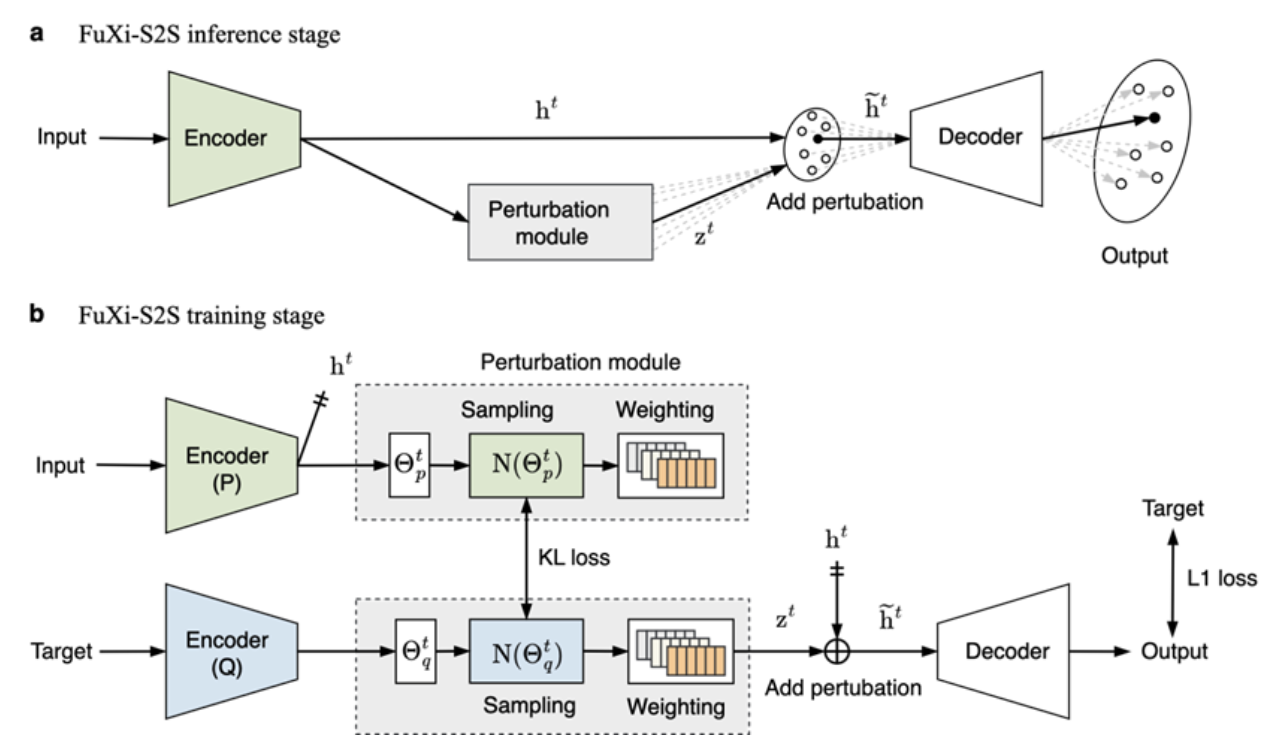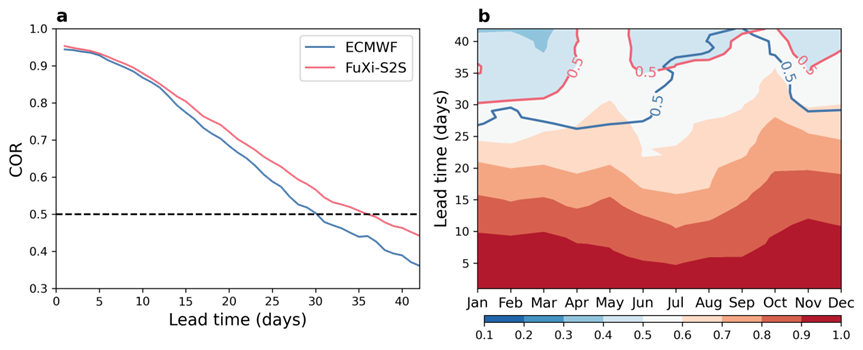
1. Editor | ScienceAI
- Author | Fuxi team
The "Outline for High-Quality Meteorological Development (2022-2035)" issued by the State Council clearly states that it is necessary to "forecast major weather processes one month in advance", and this It is inseparable from sub-seasonal climate prediction technology of more than 15 days.
Sub-seasonal climate prediction focuses on climate anomalies in the next 15 to 60 days, which can provide important support for production arrangements in agriculture, water conservancy, energy and other fields.
Compared with short- and medium-term weather forecasts with a validity period of less than two weeks, sub-seasonal climate forecasts have greater uncertainty. It not only needs to consider the initial value problem, but also consider the impact of boundary forcing. The prediction sources are more complex and the prediction skills are less. Therefore, sub-seasonal climate prediction has always been called the "predictability desert". Due to its complexity, even the performance of large AI models on time scales has not been able to surpass traditional models for a long time.
In order to solve this problem, the Shanghai Institute of Science and Intelligence (referred to as SIRI), Fudan University, and the National Climate Center of the China Meteorological Administration jointly developed the "Fuxi" sub-seasonal climate prediction model (FuXi-S2S), which for the first time surpassed traditional numerical forecasting The model benchmark - the S2S model of the European Center for Medium-Range Weather Forecasts (ECMWF).
Recently, the paper entitled "A Machine Learning Model that Outperforms Conventional Global Subseasonal Forecast Models" was published in the authoritative international comprehensive journal "Nature Communications".
As a machine learning model, the "Fuxi" sub-seasonal climate prediction model contains relatively comprehensive variables:
5 upper-altitude atmospheric variables in 13 pressure layers
- 11 ground variables
- Its unique It is able to generate large ensemble forecasts quickly and efficiently, completing global daily average forecasts up to 42 days in about 7 seconds.
This forecast information is crucial for agricultural planning, resource management, disaster preparedness, and protection against extreme weather events such as heat waves, droughts, cold waves, and floods.
The "Fuxi" large-scale subseasonal climate prediction model has achieved two key technological innovations:
Introduced the air-sea interaction process, especially the tropical atmospheric intraseasonal oscillation (MJO), the most important sub-seasonal factor. The source of predictability is incorporated into the model;
- Innovatively designed an intelligent perturbation generation module in the latent space, which can describe the probabilistic characteristics of the climate system evolution at a future forecast time under the current climate system state, thereby effectively grasping the climate system's Physical uncertainty.
- These technological breakthroughs have significantly improved the model's global prediction ability of precipitation, especially in extratropical areas such as the middle and lower reaches of the Yangtze River in my country.
Illustration: Overview of process architecture. (Source: Paper)
The MJO is a periodic atmospheric circulation pattern that affects areas from the tropics to mid- and high-latitudes. Forecasting the MJO can help meteorologists and climatologists more accurately understand and predict precipitation patterns, storm activity, temperature changes, and the occurrence of extreme weather events such as droughts and floods in the weeks to months ahead.
The "Fuxi" large sub-seasonal climate prediction model has effectively improved the prediction skill of the MJO, reaching 36 days, which significantly exceeds the 30-day duration of the ECMWF's S2S model.
Illustration: Real-time multivariate Madden of the ensemble mean between ECMWF subseasonal-to-seasonal (S2S) forecasts (blue) and FuXi-S2S forecasts (red) using all test data from 2017 to 2021 - Julian Oscillation (MJO) (RMM) Bivariate Correlation (COR) for comparison. (Source: paper)
In addition, the "Fuxi" sub-seasonal climate prediction large model can also identify potential information leading to extreme events by constructing a saliency map. This ability is useful in predicting extreme rainfall during the 2022 Pakistan floods. aspect has been verified.
The specific process is to first define a loss function, such as the average precipitation anomaly percentage in Pakistan marked by the green box in the figure below, keep the model parameters fixed, and then solve the gradient through backpropagation and finally output the gradient of the input image pixels to reflect the input The positive and negative correlation effects of meteorological elements on the precipitation anomaly percentage in Pakistan.
With the powerful prediction capabilities and precursor signal identification capabilities of the "Fuxi" sub-seasonal climate prediction model, effective tools and strategies can be provided to deal with extreme weather events.

Illustration: Comparative analysis of ECMWF subseasonal to seasonal (S2S) model and FuXi-S2S model for 2022 flood predictions in Pakistan, and precursory signals that contribute to accurate predictions by the FuXi-S2S model. (Source: paper) Outlook
In the past, only a few countries in the world were able to develop and operate traditional numerical prediction models in real time. Their development and operation required a lot of manpower and computing resources, and relied on thousands of CPUs on supercomputers.
Today, AI-based models such as the Fuxi Meteorological Model run faster and require less computing resources after training, providing a more affordable option for developing countries.
Artificial intelligence also has broad room for development in the field of climate change risk management. It can change the research paradigm of climate science, break through the limitations of traditional models, and achieve precise climate risk forecasting with finer spatial resolution and longer time scales. This technology will be widely used in extreme climate prediction, transportation, insurance, new energy, futures trading, urban planning and other industrial fields.
Currently, the "Fuxi" large sub-seasonal climate prediction model still has room for improvement. For example, its spatial resolution is 1.5 degrees, which is still relatively rough compared with the 36 km spatial resolution of the ECMWF sub-seasonal model. The current forecast is daily average Temperature, lack of daily maximum temperature and daily minimum temperature, etc.
In addition, the "Fuxi" sub-season large model is also exploring increasing the maximum pressure layer from the current 50hPa (hundred Pascals) to 1hPa or even near space, enabling more application scenarios.
About the authors
Chen Lei, a researcher at Shanghai Institute of Technology, Zhong Xiaohui, a postdoctoral fellow at the Institute of Artificial Intelligence Innovation and Industry at Fudan University, and Wu Jie, deputy director of the Climate Research Open Laboratory of the China Meteorological Administration, are the co-first authors of the paper. Qi Yuan, dean of Shangzhi Institute and Haoqing Distinguished Professor of Fudan University, Li Hao, deputy dean of scientific research of Shangzhi Institute and researcher of Fudan University Artificial Intelligence Innovation and Industry Research Institute, and Lu Bo, researcher of the Climate Research Open Laboratory of China Meteorological Administration, are co-authors of the paper. Corresponding author.
All authors: Lei Chen, Xiaohui Zhong, Hao Li#, Jie Wu, Bo Lu#, Deliang Chen, Shang-Ping Xie, Libo Wu, Qingchen Chao, Chensen Lin, Zixin Hu & Yuan Qi# (# indicates communication Author)
Paper link: https://www.nature.com/articles/s41467-024-50714-1
The above is the detailed content of Nature sub-journal, Shanghai Institute of Technology, Fudan University, and China Meteorological Administration develop sub-seasonal AI large model 'Fuxi' to break through the 'predictability desert'. For more information, please follow other related articles on the PHP Chinese website!










